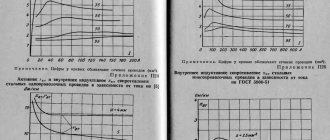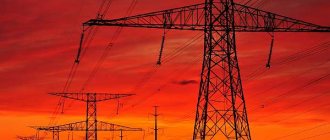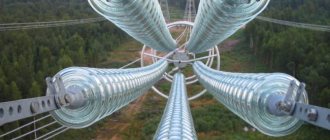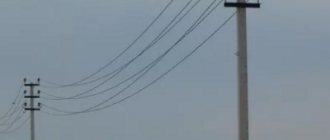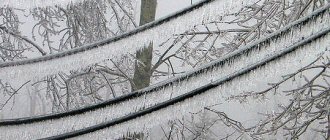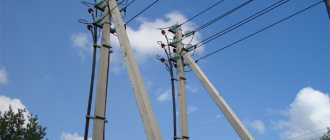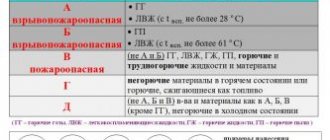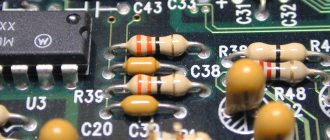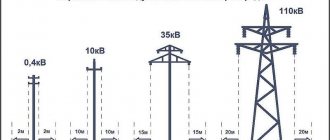The security zone of the power transmission line determines the restrictions set forth in regulations for activities in its area. First of all, the prohibitions are aimed at protecting a person from the magnetic fields of a conductor. The boundaries of spaces with a special regime around cable lines depend on the power of these objects, voltage class, purpose (power or communications), and location of installation. There are no infringements of property rights, but there are restrictions on construction, excavation work, and other actions, violation of which is fraught with fines and restitution (reduction to the previous form, for example, demolition of buildings).
The importance of protection from electromagnetic fields
Powerful voltage and currents of power lines provoke electromagnetic fields. Short-term exposure is not harmful, but continued exposure can critically impair the functioning of the body. First of all, the influence is expressed in the incorrect activity of the nervous system. Migraines, headaches, dizziness, sleep disturbances, and constant fatigue are observed. Separately, it should be noted the danger for pregnant women - the risk of incorrect fetal development increases. Particularly long-term exposure leads to cancer.
Foreign studies prove the impact of magnetic induction fluxes measured in Tesla. There are no domestic standards for this value, but according to foreign sources, the normal level of this phenomenon for people is 0.2–0.3 µT; on power lines it is much higher.
It is important for all owners and users of areas with power lines to know the safe distances from the lines to preserve their health.
The security zone of communication lines located on private or other lands is intended to prevent damage to cables and interference.
Why are high-voltage poles located on or near a dacha (residential) plot dangerous?
In the city, you will almost never find housing built near power lines, because there are a lot of organizations here that monitor compliance with standards during the construction of buildings. But in the suburbs you can find entire settlements in the zone of high-voltage wires.
What effect does radiation from a power line have on the human body?
When buying a summer cottage near a high-voltage power line, it is advisable to know in advance what you are risking. Research conducted by scientists in Sweden and Finland says that even electromagnetic radiation of low intensity, not exceeding the norm, can lead to disturbances in the functioning of the nervous system. This appears in the form:
- frequent headaches;
- chronic fatigue;
- sleep problems;
- feelings of depression.
Even minimal electromagnetic radiation from computers and laptops can cause health problems
If the radiation norm is significantly exceeded, and the time of exposure to radiation is long, more serious health problems begin:
- the body's defenses weaken;
- the functioning of the endocrine system deteriorates;
- there are problems with childbearing;
- Various chronic diseases arise, including cancer.
It is clear that, depending on the state of health and the individual characteristics of the body, the negative impact of electromagnetic radiation can manifest itself either very weakly or pronouncedly.
Sometimes the proximity of power lines can even cause the inability to get pregnant
How are power line zones regulated?
Regulatory sources:
- GOST 12.1.051-90 (hereinafter referred to as “GOST”). Main document. Contains, in particular, concepts, installation rules, parameters of security zones, distances, safety of work in the presence of electromagnetic fields, restrictions;
- Government resolutions N 160 (02/24/2009) and N 1033 (11/18/2013): the establishment procedure, specify the interaction, coordination of work with the companies operating the lines. More specifically, the distances and permitted manipulations are given;
- SanPiN 2.2.1/2.1.1.1200-03 and 2.1.2.2645 (SanPiN 2.1.2.1002-00, 2971-84 are not valid), development is regulated;
- Town planning, Land codes.
- via communication lines and fiber optic lines: main acts: resolution N 578 (procedure for establishing zones), SanPiN 2.1.8/2.2.4.1383-03;
- Federal Law “On Communications” (Article 10 only);
- Federal Law “On Cadastre” (registration of zones).
The provisions of GOST concern security segments, they prescribe safe clearances from live parts with 1000 V and above. For special personnel, work rules are also established by internal acts on electrical safety, PUE.
Confiscation is not carried out, that is, the security zone of electrical networks located in private ownership does not affect the right of ownership itself, but affects other rights, namely use (Article 56 of the Land Code of the Russian Federation). A special status is introduced that restricts activities that violate the objectives of the zones. Such infringements are introduced by acts of local self-government and judicial ones.
Classification of protected areas with power lines
All protective zones are divided into several types. The criteria for classifying these territories are the voltage level of power lines, the number of conductors, fuses (insulators), and the width of the protected area.
Line voltage classes
Depending on the voltage value of the current flowing through the wires, all power lines are divided into 5 main classes:
- Low voltage (up to 1 kV);
- Medium voltage (1-35 kV);
- High voltage (110-330 kV);
- Ultra-high voltage (from 550 to 750 kV);
- Ultra-high voltage (communications with operating voltage exceeding 750 kV).
By number of cores
Depending on the voltage, the power line may consist of the following number of wires (cores):
- 3 current-carrying wires arranged in the shape of a triangle - typical for lines with voltages up to 20 kV;
- 5 wires arranged horizontally - typical for high-voltage communications with voltages up to 220 kV;
- 7-8 wires arranged in a “reverse tree” and hexagon pattern - an arrangement used for double-circuit lines with high voltages of 330 and 750 kV.
By the number of fuses (insulators)
Depending on how many insulators are installed on power lines that protect communication from the flow of current through the metal support, they are of the following types:
- With 4-5 small pin insulators on one support - typical for lines with an operating voltage of no more than 0.4 kV;
- With 3 large pin insulators on one support (6-10kV);
- With 6-7 suspended composite insulators (garlands) on each support (35 kV). Each “garland” consists of 3-5 porcelain or glass insulators.
- With 10-12 composite suspension insulators (high-voltage lines (HVL) 110-330 kV).
- With 20 composite suspension insulators (550 and 750 kV).
In the most powerful 1150 kV lines, the wires are attached to the supports using 20 or more insulators.
Zone sizes
The width of the security zone for different voltage classes of power lines, regulated by Decree of the Government of the Russian Federation No. 160, is indicated in the table in the picture below.
Width of security zones for overhead power lines
An underground cable communication channel, a cable line located in the ground through which power transmission is carried out, have a protective zone of 0.6-1.0 meters.
Important! The width of the security zone passing over a body of water (lake, river, reservoir) must be at least 100 m on both sides of its outer border
The concept of security zones of power lines
Power transmission line security zones are conventional planes, spaces (segments, sections) along and around power lines with boundaries established by standards.
The goals are to limit:
- a person being near power lines due to the harmful effects of electromagnetic fields on health, the risk of electric shock;
- activities that could damage the power lines themselves.
The area in question is the space from the power line to the ground with the specified width. That is, this is an area with an increased danger to human health, limited by conventional planes vertically, on the left, on the right. The boundaries are measured not from the cables themselves, but according to GOST rules, since they depend on the radiation power and specific technical requirements.
According to SanPiN 2.2.1/2.1.1.1200-03, the areas in question near overhead power lines (OHL) belong to one of the types of sanitary protection zones (SPZ), called sanitary breaks.
There are not only territories with a special regime for power lines: the security zone of communication lines also implies a protective status with restrictions on use.
Results and conclusions
Before concluding a deal to purchase a plot of land, you should clearly define the purpose of the purchase. If you are going to use the plot for gardening needs, agricultural crops, then the bargain price will be an incentive for you. But if you decide to build a house or a store, or another permanent structure, you should study the documents very carefully, using all available sources. So that instead of a joyful purchase you end up with a lot of additional expensive problems. A legally established protection zone for power lines imposes a large number of restrictions on the owner of the site. Upon reflection, all these restrictive and punitive measures are aimed at preserving the life and health of people and property. They protect against fires, explosions, and serious accidents. Laws and regulations set by the state must be followed and carefully studied. Then any purchase will bring only joy and benefit.
Read also: Installing a cell tower near your home: harm to health, distance
How to establish a power line zone
Security zones are formed at all facilities in the electrical grid sector in accordance with the requirements of regulations regarding the boundaries of such spaces. The sizes are determined by network organizations or other owners of such infrastructure and equipment.
Rules for establishing security zones:
- The network enterprise submits documents to the energy supervision authority to authorize the allocation with a detailed description of the parameters. The decision is made within 15 days;
- government agency for 5 days. sends documents to the cadastre. The allocation is considered completed from the date of updating the cadastral registration, which also displays information about the applicant and the responsible company.
Width along overhead, underground, over water lines
Rules for the width of zones along the infrastructure:
- security zone of high-voltage overhead power lines (all distances are measured from the outermost wires): space above the ground with parallel vertical frames spaced horizontally according to Table 1 of GOST, determined by voltage (kV);
- over bodies of water. Above-water space with parallel vertical boundaries on the sides. For navigable objects - 100 m. For non-navigable objects - according to the table. 1;
According to SanPiN 2.2.1/2.1.1.1200-03 (clause 3.3), the parameters of sanitary ruptures for overhead lines are as follows:
Gaps can be corrected based on the results of instrumental examinations, as well as if there are devices to reduce the electric field strength. Resolution N 160 clarifies the distances, in particular, prescribes the intervals for 1–20 kV:
The dimensions are determined using tables, for example, the security zones of 6 kV power lines are 10 or 5 m wide.
Security zone of underground cable 10 kV
During inspections of electrical grid facilities under construction (reconstruction), specialists from the Department of State Housing and Construction Services often identify the implementation of economic activities (storage of building structures, building materials, timber, etc.) in their security zones.
Restrictions on the use of land plots and capital construction projects in the territory of security zones are determined on the basis of the “Rules for the establishment of security zones of electric grid facilities and special conditions for the use of land plots located within the boundaries of such zones”, approved by Decree of the Government of the Russian Federation dated February 24, 2009 No. 160 (hereinafter referred to as Rules).
The security zone of power grid facilities is established in order to ensure safe operation and operation, to exclude the possibility of damage to power lines and other power grid facilities (clauses 1, 2 of the Rules).
In particular, security zones are established: along overhead power lines, along underground cable power lines, along underwater cable power lines, along crossings of overhead power lines through bodies of water (rivers, canals, lakes, etc.) - clause “a” of the Boundary Requirements establishing security zones for power grid facilities (Appendix to the Rules).
In security zones, it is prohibited to carry out any actions that could disrupt the safe operation of electrical grid facilities, including leading to their damage or destruction and (or) causing harm to the life, health of citizens and property of individuals or legal entities, as well as causing environmental damage and the occurrence of fires (clause 8 of the Rules).
Security zones of power grid facilities are established:
a) along overhead power lines - in the form of a part of the surface of a plot of land and airspace (to a height corresponding to the height of the supports of overhead power lines), limited by parallel vertical planes spaced on both sides of the power line from the outermost wires when their position is not deflected at the following distance:
| Design rated voltage class, kV | Distance, m |
| up to 1 | 2 (for lines with self-supporting or insulated wires laid along the walls of buildings, structures, etc., the security zone is determined in accordance with the minimum permissible distances from such lines established by regulatory legal acts) |
| 1 — 20 | 10 (5 - for lines with self-supporting or insulated wires located within the boundaries of populated areas) |
| 35 | 15 |
| 110 | 20 |
| 150, 220 | 25 |
| 300, 500, +/- 400 | 30 |
c) along underwater cable power lines - in the form of a water space from the water surface to the bottom, limited by vertical planes spaced on both sides of the line from the outer cables at a distance of 100 meters; b) along underground cable power lines - in the form of a part of the surface of a plot of land located underneath the subsoil plot (to a depth corresponding to the depth of laying cable power lines), limited by parallel vertical planes spaced on both sides of the power line from the outer cables at a distance of 1 meter (when passing cable lines with voltage up to 1 kilovolt in cities under sidewalks - 0.6 meters towards buildings and structures and 1 meter towards the roadway);
d) along the transitions of overhead power lines through bodies of water (rivers, canals, lakes, etc.) - in the form of air space above the water surface of reservoirs (to a height corresponding to the height of the supports of overhead power lines), limited by vertical planes spaced on both sides of the power line from the outermost wires in their non-deviated position for navigable bodies of water at a distance of 100 meters, for non-navigable bodies of water - at the distance provided for the establishment of security zones along overhead power lines;
e) around substations - in the form of a part of the surface of the land and airspace (to a height corresponding to the height of the highest point of the substation), limited by vertical planes spaced from all sides of the substation perimeter fence at the distance specified in subparagraph “a” of this document, as applicable to the highest voltage class of the substation.
The requirements provided for in subparagraph “a” are applied when determining the size of clearings.
During the construction (reconstruction) process, economic activities (storage of building structures, building materials, timber, etc.), including by subcontractors, must be carried out in accordance with the requirements of the construction organization project.
When conducting an inspection of a completed construction (reconstruction) of an object, the security zones of electric grid facilities must be brought to standard conditions, construction materials and products must be removed beyond their boundaries, including cleared of small forests and reclaimed.
Type of power line and voltage, how to determine visually
What voltage is in the power line, and accordingly, what are the parameters of the zone, will be found out at the local power supply. You can roughly determine the characteristics by analyzing the appearance of the high-voltage line. Security zone of 10 kV and 0.4 kV power lines are the most common in populated areas.
These overhead lines are usually located in cities, equipped with SIP or aluminum wire on relatively low supports with oversized insulators - white, brown, glass (transparent). Overhead lines with 10 kV and more are equipped with large insulators, often they are brown ceramic, the height of the support is about 9 m. Lines with 0.4 kW also have a security gap, but much smaller, up to 2 m.
“Aerial towers” of 35–750 kV and more are the highest and largest supports, usually located on the outskirts of populated areas. In the forests, special clearings are cut down for them, with a width equal to the protective zones, however, as well as for other types of power lines. Towers for 35, 110, 220 kV are equipped with one core per phase, and then, according to power options, respectively, 300 - 2, 500 - 3, 750 - 4 or 5. Insulating garlands differ in the number of “plates”: 35 kV - 3 or 5 pcs., 110 - 6 or 8, 220 - 10 or 15, 500 and 750 - from 20.
Exceptions and notes
- The passage of power lines through the territories of educational institutions, children's institutions and stadiums is prohibited.
- For power transmission lines (overhead lines) with a power of up to 20 kV, the location of the outermost wires is allowed at least 20 meters away from private houses, cottages and other residential buildings.
- It is prohibited to locate power lines (overhead lines) directly above buildings and structures.
- It is allowed to pass power lines (overhead lines) over industrial structures with I-II degree of fire resistance in accordance with the rules of construction and fire safety for roofs made of non-combustible materials.
- For overhead lines from 330 to 750 kV, passage is allowed only over electrical substation buildings.
In the territory of power transmission line protection zones it is prohibited:
- Conduct construction, demolish buildings and any structures;
- Carry out agricultural and reclamation work, plant trees and other crops;
- Carry out mining and blasting operations;
- Block passages to power line supports;
- Locate gas stations;
- Organize landfills for garbage, snow, etc.;
- Store animal feed, hay, fertilizers;
- Spread the fire;
- Place transport stops and other objects that cause large crowds of people.
Carrying out any work and activities in territories belonging to power transmission line security zones is possible only after obtaining written permission for such work from the organization in whose department the power transmission line network data is located.
If persons violate the set of “Rules for the Protection of Electrical Networks,” voltages over 1000 V, if this causes interruptions in the operation of networks and electricity supplies, may become a reason for administrative penalties:
- Fine in the amount of 5 to 10 minimum wages for individuals;
- A fine of 100 to 200 minimum wages for legal entities.
Rules for work in protected zones
Permitted construction and installation work is usually only those that relate to the maintenance of supports and are carried out by special personnel. Such activities in areas with special regimes must be controlled by a responsible person, subject to compliance with electrical safety requirements in accordance with GOST 12.1.019. If it is impossible to comply with these, then work begins after the tension is removed.
Minimum safety measures: before starting, instructions are required, personnel are given protective equipment (insulator gloves, etc.), protective fences are installed, and workplaces are isolated. If the risk of touching current-carrying parts is increased, then protective grounding and grounding are provided. The insulation resistance is measured with special instruments to determine its sufficiency. The responsible person has the right to check the staff’s knowledge of basic safety rules and instructions.
If the work affects the ground or soil, then make sure that there are no underground high-voltage lines. Damage to cables by an excavator is a traditional phenomenon. If current enters the equipment, it may fail, but the main danger is the risk to the life of the excavator operator himself.
Construction on a territory with a special regime must be coordinated with the network company. If the owner has already built a house and they are planning a high-voltage installation through the adjacent territory, then such actions are coordinated with him, and coercion in the form of a court decision is possible, but the network company is always obliged to compensate for the inconvenience.
If work is carried out on overhead lines and contact with conductors is not required (there is no such contact during manipulation), the gap from a person to the closest conductor should be at least 2 m.
It is generally accepted that the distance from the pointer crane, from any part of it, of the lifted load is at least 20 m, optimally 30 m to the nearest wire. But the gap may be smaller depending on the line voltage: there are tables compiled on the basis of regulations. The crane operator must be issued a work permit, which is possible only after instructions.
Is it worth buying a plot with a security zone?
A plot of land next to power lines is often inexpensive. This is due to the duality of property status. The owner cannot dispose of the plot as he wants. He must coordinate his actions with the organization that owns the energy networks in the given territory. Having built a house without permission from the electrical network, the owner will not be able to register it with the cadastral register.
How to check the presence of a security zone on a site
IMPORTANT: You can complete purchase and sale transactions with such property without any problems. If you received a building plot from the municipality, and it later turned out that it is located in the power transmission line protection zone, it is better to refuse such a gift with encumbrance.
The presence of encumbrances must be reflected in the cadastral passport or certificate of ownership. The main limitation in the case we are considering is the prohibition of housing construction in the power transmission line security zone. If permission is obtained, then it will be possible to build commercial facilities on the site that do not require long-term presence of people. If you violate onerous requirements, you will have to pay a fine (individuals 5-10 minimum wages, and legal entities from 100 to 200 minimum wages).
When purchasing a plot of land, you must order an extended extract from the Unified State Register of Real Estate and study the public cadastral map on the Internet.
Read also: Unified State Register - what is it: decoding
The fastest way to check the presence of security zones on a site is on a public cadastral map. To do this, click on the “Layers” button and check the box next to “Protection zone of artificial objects”. Protected zones included in the cadastre will be highlighted in green.
What is prohibited in power transmission line protection zones
Within the boundaries of the protective and sanitary space, actions that threaten the normal operation, the stability of the operation of lines, during which a danger is created for people, for the operability of the facility, or the possibility of fires, are strictly prohibited.
Directly prohibited work in the security zone of power lines (we will indicate the general list according to GOST; in R. III of Resolution 160 it is more detailed):
- placement of objects with fuels and lubricants, flammable liquids, flammable liquids;
- landfills;
- events related to explosions;
- starting a fire;
- discharge, discharge of caustic, corrosive mixtures, fuels and lubricants;
- throwing, approaching objects to supports, wires;
- you cannot climb on structures;
- any actions and stay in a segment with a special regime during thunderstorms or extreme weather.
What is prohibited without the consent of the service organization (work is highlighted separately as such, which is possible, but with the consent of the responsible enterprises, according to Resolution No. 160, paragraph 10):
- construction and installation activities, watering, planting, cutting down, as well as storing feed, fuel, etc. It is forbidden to develop roads for vehicles and machinery with a height exceeding 4.5 m;
- if the installation is underground, then excavation work and leveling using earth-moving equipment are prohibited;
- For underwater lines, activities affecting the bottom soil, arrangement of berths, movement with loose anchors, trawls, etc. are prohibited. Watering places and the allocation of fishing areas are prohibited;
- for overhead power lines, work with lifting and retractable structures is permitted if the gap from the housing, transforming segments, and objects being lifted to the closest wire is not less than according to table. 2 GOST.
Irrigation works
In GOST, irrigation works are highlighted as separate points, since they pose an immediate danger due to the increased conductive properties of water in any of its forms (splashes and even sprayed small drops). Such activities are permissible in any weather, if the stream is outside the protected space, and also if it enters it, but does not rise above 3 m from the ground.
Do's and don'ts
The Rules for the Protection of Electrical Networks Located on Land Plots clearly stipulate prohibitive measures.
What actions are prohibited in the power transmission line security zone?
It is strictly forbidden to:
- Throw any things, sticks, or other objects onto wires or poles.
- Climb somehow onto poles with overhead line wires.
- Do not fly kites, aircraft, or drones that could get caught on wires.
- Light fires near the transformer substations and overhead lines.
- The operation of impact mechanisms and the dumping of loads exceeding 5 thousand kg are prohibited.
- It is forbidden to dump or drain waste that is caustic or corrosive to metal. The same applies to fuel and lubricants.
- Create spontaneous garbage dumps that can spontaneously combust.
- On land in a protected zone sown with agricultural plants, crops should not be treated with poisons, fertilizers, which contain chemical elements that can destroy supports and cables.
- Without written approval from the network organization that owns the power transmission line, you cannot plant or cut down vegetation or carry out loading and unloading operations using a crane. You cannot dig the soil deeper than 30 cm. Watering plants with a stream of water higher than 3 m is prohibited.
To build a residential building or other capital construction project (garage, outbuilding, permanent fence), it is necessary to obtain a permit from the Department of Architecture (in urban areas) or from the administration of a rural settlement.
Before this, it is necessary to coordinate the project with representatives of those organizations that own communications located in the security zone. There are cases when a network organization - the owner of some specific communications refuses to approve a project without justifying its refusal, relying on legislative norms. Then you need to go to court.
IMPORTANT TO REMEMBER: In the Decree of the Government of the Russian Federation No. 1622 of December 21, 2018, paragraph “a” states a ban on the placement of children's and sports grounds, stadiums, markets, retail outlets, field camps, cattle pens, garages and parking lots of all types of machines and mechanisms, garden, vegetable plots of land and other real estate located within the boundaries of the territory where citizens engage in gardening or vegetable gardening for their own needs, housing construction projects, including individual ones (in security zones of overhead power lines).
What requirements are met for safety in the power line area?
You cannot approach a lying wire at a close distance: the voltage on high-voltage supports is sufficient to create an electric arc, so the optimal safe distance is large - from 8 m. A shorter distance does not necessarily mean electric shock, but it is highly advisable to leave the place as quickly as possible. In this case, the steps should be small, the feet should be tried not to be lifted off the ground, which will eliminate the so-called step tension, which can be critical for health.
If you find very sagging cables, you should not move in their direction and should not cross them. The design of the overhead line support is designed to hold them at a certain distance from the surface, taking into account voltage, current, and other parameters. If this clearance is compromised, there is obviously a risk of hazards occurring near the ground. If the wire is very slack, then electric shocks and arcing cannot be ruled out. A short-term last phenomenon and sparking are signs of a life-threatening emergency; you should stay away from such areas. Before crossing the zone, it is recommended to visually check the absence of the listed circumstances.
Field and voltage limits
The maximum degree of electromagnetic fields (EMF) for the population is prescribed in SanPiN 2.1.2.2645 (R. VI):
- weakening of the geomagnetic field in residential buildings - 1.5;
- electrostatic strength - 15 kV/m;
- within the boundaries of populated areas - alternating electric field strength with 50 Hz at a height of 2 m - 1000 V/m, inside residential buildings at a height of 50 cm - 2 m - 500 V/m. The range is given in appendix. 7;
- The EMF range for 30 kHz - 300 GHz is in the table. 6.
Prohibited actions
The following work is not allowed in the sanitary zone:
- Construction of buildings and structures for any purpose, as well as their demolition and repair, if they already existed (the rules allow the passage of overhead lines over some industrial buildings and electrical structures).
- Placing stadiums, transport stops, holding any group events with large crowds of people.
- Carrying out reclamation work, planting trees, watering land, as well as mining and blasting operations.
- Storage of hay, equipment of storage facilities for feed and fertilizers, various landfills and gas stations.
- Open fire.
- Obstruction of travel routes and approaches to overhead line supports.
Plots of land that fall within the power transmission line protection zone will not be confiscated from their owners. Land plots can be exploited at will, as well as sold or donated.
Potatoes or other crops can be planted on plots of land. But at the same time, one should take into account the risks of possible loss of part or all of the crop at any time (in cases of repair and emergency work on the line, the passage of equipment), and also observe the rules for being on the sanitary territory of power lines (do not erect buildings, do not dig pits, do not burn grass and not perform other prohibitive actions).
Security zones of communication lines
Communication lines include linear cable objects, communication objects, signal transmission objects, and physical circuits. Federal Law “On Communications” (Article 10) states that the establishment of protective zones and the creation of clearings is regulated by land legislation, and the main provisions are spelled out in Government Decree N 578 and SanPiN 2.1.8/2.2.4.1383-03
The security zone of communication lines has how many meters:
- for infrastructure, underground communications and overhead lines, radio installations - lengthwise segments with a width of 2 m;
- for marine laying and for communications through navigable, raftable water bodies - segments to the bottom, spaced 0.25 nautical. miles on the sides or when crossing water bodies - by 100 m;
- for autonomous structures to increase the signal, with regeneration functions - segments with a closed boundary with a width from the center of the equipment or from the embankment of at least 3 m and from the grounding contours of at least 2 m.
What is prohibited
The security zone of communication lines established by law prohibits, without the written consent and presence of representatives of operating institutions:
- installation, construction, blasting work, as well as soil leveling with digging equipment (except for areas with sand dunes) and earthworks (except for plowing to a depth not exceeding 0.3 m);
- activities: geological surveys related to prospecting, geodesy and other survey activities involving drilling, trenching, and sampling;
- planting trees, placing field camps, keeping livestock, storage, fires, shooting ranges;
- driveways, parking lots;
- transportation of goods under wires;
- arrangement of canals (aryks);
- barriers, obstacles;
- berths, unloading and loading operations;
- underwater technical, dredging, dredging work;
- allocation of fishing grounds, extraction of fish, other aquatic life, vegetation with benthic devices;
- watering places, splitting, ice making;
- you cannot drop anchors, passages with dropped anchors, chains, trawls, etc. are prohibited;
- any construction or reconstruction activities related to lines;
- protection of underground communications without taking into account underground installations;
- It is forbidden to move signs or infrastructure structures during construction work.
It should be emphasized that the security zone of communication lines allows the placement of the above, but only with the consent of the responsible company.
Actions that threaten the operation of communication lines and radio installations are strictly prohibited, for example:
- reconstruction, demolition of buildings, bridges, reconstruction of collectors, tunnels, infrastructure where cables and related objects are laid (poles, technical structures, etc.) without prior removal of lines with the permission of service companies;
- backfilling of highways, arrangement of permanent warehouses on them, as well as drains and landfills;
- break any signs, fencing structures, telephone wells;
- open hatches and doors of communications and infrastructure facilities (wells, boxes, etc.);
- install fences to prevent access for technical personnel;
- other actions that create a risk of damage to communication lines and associated objects;
- It is prohibited to fill the hatches of wells, cabinets, signs, fences and similar objects with garbage and earth.
If excavation of the soil is allowed by the service company, then it is carried out only with shovels without sharp impacts (with the exception of plowing at 0.3 m). Do not use impact devices (crowbars, picks, pneumatic devices).
Security zone of underground cable 10 kV
Explain the specifics of the application of certain provisions of the “Rules for the establishment of security zones of electric grid facilities and special conditions for the use of land plots located within the boundaries of such zones” (approved by Decree of the Government of the Russian Federation dated February 24, 2009 No. 160).
1. Do all the requirements of subparagraph “b” of paragraph 9 apply to the security zones of underground cables? Is it necessary to remove parking lots of passenger cars from the security zone of the 10 kV underground cable, complying with subparagraph “b” of paragraph 9 of the Rules?
2. Paragraph “d” of the appendix “Requirements for the boundaries of establishing security zones of electric grid facilities” to the Russian Federation Regulations dated February 24, 2009 No. 160, indicates the need to establish security zones for transformer substations. According to these requirements, is a security zone established for a substation to which only underground cables are suitable?
In the security zone of the cable line, it is prohibited to store materials, arrange landfills, or place objects on passages and entrances to power grid facilities. Without the written approval of the electrical network organization, construction, major repairs, reconstruction or demolition of buildings and structures, excavation work at a depth of more than 0.3 meters and soil leveling in the security zone of an underground cable line are prohibited. The ban on the placement of children's and sports grounds, stadiums, markets, retail outlets, garages and parking lots of cars and machinery applies to security zones of overhead power lines and does not apply to security zones of cable lines.
The security zone around the transformer substation is established in accordance with subparagraph “e” of the Appendix to the Rules, regardless of power supply via overhead or cable lines, and for transformer substations with the highest voltage class 6 - 10 - 20 kV it will be 10 meters from all walls of the transformer substation.
In accordance with the appendix to the Rules, security zones are established:
- “b) along underground cable power lines - in the form of a part of the surface of a plot of land located underneath the subsoil plot (to a depth corresponding to the depth of laying cable power lines), limited by parallel vertical planes spaced on both sides of the power line from the outer cables at a distance of 1 meters (when passing cable lines with voltage up to 1 kilovolt in cities under sidewalks - 0.6 meters towards buildings and structures and 1 meter towards the roadway);
- e) around substations - in the form of a part of the surface of the land and airspace (to a height corresponding to the height of the highest point of the substation), limited by vertical planes spaced from all sides of the substation perimeter fence at the distance specified in subparagraph “a” of this document, as applicable to the highest voltage class of the substation.”
At the same time, according to paragraph 8 of these Rules, “In security zones it is prohibited to carry out any actions that may disrupt the safe operation of electrical grid facilities, including leading to their damage or destruction, and (or) causing harm to the life, health of citizens and property individuals or legal entities, as well as cause environmental damage and fires, including:
- b) place any objects and objects (materials) within the passages and entrances created in accordance with the requirements of regulatory and technical documents for access to power grid facilities, as well as carry out any work and erect structures that may impede access to power grid facilities, without creating the passages and entrances necessary for such access;
- d) place landfills;
- e) carry out work with impact mechanisms, dump weights weighing over 5 tons, dump and drain caustic and corrosive substances and fuels and lubricants (in the security zones of underground cable power lines).”
In accordance with paragraph 9 of the Rules “In security zones established for electrical grid facilities with voltages over 1000 volts, in addition to the actions provided for in paragraph 8 of these Rules, it is prohibited:
- a) store or place storage facilities for any materials, including fuel and lubricants;
- b) place children's and sports grounds, stadiums, markets, retail outlets, field camps, cattle pens, garages and parking lots of all types of machines and mechanisms, carry out any events associated with large crowds of people not engaged in performing work permitted in accordance with the established procedure ( in the security zones of overhead power lines).”
According to paragraph 10 of the Rules, “Within security zones, without a written decision on the approval of network organizations, legal entities and individuals are prohibited from:
- a) construction, major repairs, reconstruction or demolition of buildings and structures;
- g) excavation work at a depth of more than 0.3 meters (on plowed lands at a depth of more than 0.45 meters), as well as soil leveling (in security zones of underground cable power lines).”
With whom and how to coordinate work
The interaction with enterprises in whose jurisdiction the communication lines are located, obtaining permits and coordinating work is reflected in detail in Resolution No. 578. For power lines, such a document is Resolution No. 160. The general rules are contained in other documents indicated by us at the beginning of the article.
In all cases, during planned line maintenance work, the owner of the site is warned in writing by the responsible enterprise.
Coordination for work in communication line areas
The parameters of areas where work and tree planting are prohibited are determined by operating organizations. The boundaries and location of communication lines are created by them and agreed upon with local government (administrations) according to previously drawn up projects.
If there are security zones on plots allocated for agriculture, vegetable gardens, orchards, a note is made in the documents for such lands about the presence of segments with a special regime. The allocation of such plots is carried out by local governments in agreement with the companies operating the lines, which also inform the owner of the plot in writing about the described feature, and also determine the compensation associated with this.
For work carried out by the owner (user) of the site, the written consent of the enterprise responsible for the lines must be obtained (R. III post. N 160). Moreover, such a document must also be obtained from special supervision and control authorities for measures to identify the location of underground communications.
A developer intending to work in the zone no later than 3 days in advance. (working days) before the start of the event, he is obliged to call the responsible employee of the service company to accurately determine the location of the cables. Based on the results of the analysis, a report is drawn up. The line is marked with poles and signs. Workers are familiarized with the hazard data and the information received. Developers notify the responsible company about the start of activities no later than 3 days in advance. Work is prohibited until a representative arrives at the site.
The enterprise is obliged to compensate land owners for losses associated with the maintenance of communication lines and power lines.
Coordination of work in security zones of power lines
To approve work in the security zone of an overhead line or another type (underground, underwater), interested parties submit an application to the network organization no later than 15 working days. days The latter is obliged to consider the application within two days and make a decision on approval. The application must be accompanied by a project, technical documentation (mandatory for blasting activities) and a description of the work.
What is possible and the rules of work in health centers
It is prohibited to be in the power line area without permits. For the duration of construction and repair work, a special permit is issued, then an order for the admission of personnel, with whom an initial briefing on labor protection is first carried out at the workplace. It takes into account all local characteristics of hazardous factors.
If it is necessary to use lifting machines or mechanisms with retractable parts, you must first check the width of the road and the quality of the surface to prevent the possibility of an accident. It is necessary to comply with the condition that the air distance from the crane (or other special equipment), from the retractable and lifting parts, the load in any position to the nearest live wire is not less than that indicated in Table 13.1. from GOST 12.1.051.
If excavation work is planned in the security zone of the cable line, you first need to open the soil to clarify the depth and location of the cable.
Bottom line
Construction in the protected zone and other work are prohibited conditionally, that is, possible with the consent of the company under whose jurisdiction this infrastructure is located. But there are also strictly prohibited events.
When analyzing information, an interested person must definitely read the regulatory documents we indicated at the beginning of the article, and especially Resolutions 160, 1033, 578, which more specifically provide lists of what is prohibited, what is allowed and in what cases, depending on the parameters of the lines. It should be noted that there are different rules: there are direct prohibitions and conditional ones (work is possible with the consent of the responsible companies), for lines of different power (up to 1000 V and above), for underground, underwater, and air communications.
Legal nuances
A wooden, or more often reinforced concrete, pole with wires standing next to a fence or on a plot of land can cause costly problems for the owner of the property.
In the event that representatives of the distribution zone find obvious violations in the footage of the power line security zone, they are authorized to draw up a report. They do not have the right to decide whether to impose a fine. But after the energy workers, the inspector of the Federal Service for Environmental, Technological and Nuclear Supervision will send an order demanding to pay a fine (500-1000 rubles). The RES will send a written request to dismantle the illegally erected structure within 10 days. As an alternative, they will propose to move the power line support to the required distance at the expense of the owner of the site. If a settlement cannot be reached, the network company will file a lawsuit.
Before the owner plans to organize construction under a power transmission line, he should carefully study the legislative norms himself or seek legal assistance in order to take into account all existing legal nuances. Especially a lot of “problems” arise when solving the question “is it possible to build a house under a high-voltage line”.
If the property has not yet been built
To avoid a conflict situation, it is necessary to resolve all organizational and legal issues before starting construction under power lines.
Submit an application to the city power grid for approval of a decision on construction in the power transmission line security zone. This must be done at least 15 days before the start of any work. Power engineers will review the request within two days and agree or refuse with reason.
If the property has already been built
Buildings, structures, and other permanent structures that were constructed without obtaining all the necessary approvals and permits in accordance with the law are classified in the Civil Code of the Russian Federation, paragraph 1.Article 222, as unauthorized construction. It is subject to demolition at the expense of the person who carried out the construction (clause 2 of Article 222 of the same code).
If there is a power line, but there is no security zone
After the adoption of the Resolution in 2009, the rule on the security zone of power transmission lines received legal recognition, which is considered established only after the data is entered into the real estate cadastre. In practice, not all zones received their place in this federal document.
Quite often there are situations when the owner of a site applies to the architecture department for permission to erect a permanent structure next to an overhead line. The local government licensing authority does not have data on the establishment of boundaries, since the RES did not take care of entering the line into the cadastre in time.
Read also: What is the cadastral valuation data fund, its functions.
After the construction is completed, legal proceedings may begin. To the question “is it possible to build a house under a high-voltage line” there is a clear negative answer. When a person buys a plot of land, intending to build housing in a populated area, and there is an overhead line nearby, he must be aware of the full extent of the risk. Even if at the time of purchase there is no information about the boundaries in the state real estate cadastre, the network organization can add them later. The court will always be able to refer to the grounds that the buyer had information that there is an object next to the site that belongs to the city energy networks. If poles with wires were already in place, then the owner of the land had to assume that there was a power line protection zone. He will lose the court case.
The procedure for removing the security zone
Most often, having received a notification about the elimination of violations in the area of unauthorized development, land owners contact the power grid with an application to move the power lines to a safe distance. If energy distributors decide that such a technical possibility exists, they provide the service for a fee. First you need to move the line outside the site. Conduct cadastral work, re-agreed boundaries, and enter information into the State Cadastral Register.
